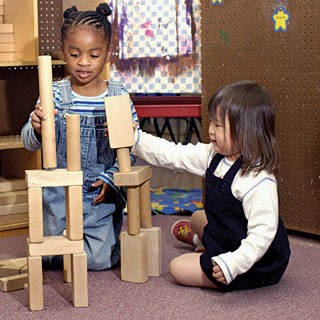Remember, for the assessment, scores are averaged. It is not necessary to score at the top of the scale on all items. If something does not fit with your philosophy, is too expensive to change, etc. no worries!
Here are some of the items that I see could be improved at multiple sites…
Furnishings for relaxation
In the ERS, this element looks for softness in the child's environment. Soft furnishings are one element: rugs, pillows, bean bag chairs, sofa, carpeting, a "cozy" area, etc. Soft toys are another element: stuffed animals, soft blocks, fuzzy balls, puppets and soft dolls, etc. This item is included because "children need softness in their physical surroundings It helps them relax and feel comfortable." Furnishings/items that allow a child to "relax, completely escaping the hardness of the typical early childhood classroom."
As with many elements of the ERS, this becomes a counting exercise. “Some” and “Many” are defined.
Room Arrangement
Consider adding labels with words/photos to shelves and containers to assist children in maintaining the environment
Child Related Display and ArtMost of the children's art that is displayed tends to be theme related, and they all look similar (all pumpkins – though each child created his/hers in their own way). ERS looks for children’s art where the child is able to pick the subject and media themselves. I see this happening all the time, but those art pieces tend to be sent home instead of posted. Consider a gallery of art that the children do completely on their own. Also, ERS looks for art displayed that is 3 dimensional – clay sculptures, woodwork, cardboard constructions…
Dramatic PlayConsider adding more “Male” dress up clothing. ERS points out that children are identifying gender roles so having both traditionally male and female dress up items is important. Include more diversity in your dramatic play. Cultural fabrics, empty food containers, dishes, etc. are easy to add. Also consider having at least 2 types of dramatic play. This could be a housekeeping scenario and also a post office, for example. Recycle your junk mail, pick up a couple of light blue shirts at the used clothing store, get some “if it fits it ships” boxes for free at the post office… One other item in this section is to consider adding dramatic play options to your outdoor area. I often see a plastic kitchen or a playhouse outside, but they have had no props at all.
Science and NatureThis has been surprisingly absent in a lot of programs. Add collections of natural objects (fall leaves, gourds, rocks, shells), have some plants or other living things, add books to your shelf that are factual with real pictures, take advantage of opportunities to talk about nature when outdoors.
Supervision of Outdoor PlayWhile the actual supervision has been great, what gets lost is the quality of the interactions between the adults and children. Gone are conversations, questions to invite thought, etc. Most of the interactions outdoors are either between the adults, or are around safety and rules. Challenge yourself to keep the high quality of interactions both indoors and out.
As I continue doing practice assessments, I'll add more. Promoting Acceptance of Diversity is one where all improve, and will have a blog post soon. And, of course, elevating interactions is an on-going work in progress!













